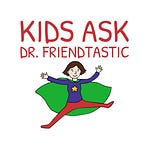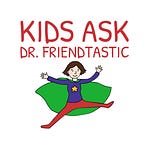Scroll down for a TRANSCRIPT, DISCUSSION QUESTIONS, and how to submit YOUR CHILD’S QUESTION.
Do you worry about your kid(s) and peer pressure? In this week’s episode, Ann wants to know how to avoid letting her friends drag her into doing something she knows she shouldn’t do. Help your child learn ways to say no without being mean or hurting a friendship.
Brand NEW up-coming LIVE webinar for kids!
Register your child (ages 6-12) to attend live on Saturday, Nov. 11, 2023, at 1 pm Eastern US time. You’ll also receive a recording afterward, if you can’t attend at that scheduled time or if you’d like to watch it again with your child.
Would YOUR kid enjoy being featured on the podcast?
Adults, please use your smartphone's memo function or an audio app to record your child's question. Hold the phone close to your child's mouth to make sure the recording is clear. Have your child state:
their FIRST NAME (or another first name),
their AGE, and
a BRIEF QUESTION or concern about friendship. (Please do not include any friends' names.)
Email the audio file to DrF@EileenKennedyMoore.com or submit it at https://DrFriendtastic.com/submit. I’ll answer as many questions as I can. (Obviously, this is not psychotherapy, and it’s not for emergency situations.)
Think About It Questions to discuss with your child
What are some positive ways your friends have influenced you?
Have you ever had friends or other kids try to influence you to do something that wasn’t smart or kind? What happened?
Why do you think it’s sometimes hard for kids to say no to friends?
Have you ever tried to influence a friend to do something? What was it? Why did you want your friend to do it? How did you try to influence your friend? How did your friend respond?
Transcript
Hi, there! I’m Dr. Eileen Kennedy-Moore, also known as Dr. Friendtastic. I’m an author and clinical psychologist based in Princeton, NJ.
Here’s today’s question:
Hi, my name is Ann. I'm 9-years old, and I have a question for you: How do we avoid being dragged along by friends to do something we're not supposed to?
Hi, Ann. Thank you for sending in your question! This is such an important topic!
Peer pressure or peer influence is when other kids—your peers—directly or indirectly urge you to do or not do something. Sometimes peer pressure can be positive. If you hang out with kids who care a lot about doing well in school, you’re probably going to care a lot about doing well in school, too. If all of your friends are trying out for the play or joining the soccer team, you’re probably going to want to try those activities, too. So peer influence can pull you toward doing things that are helpful, interesting, or enjoyable.
Sometimes peer pressure is just neutral. If your friends like to wear a certain style of clothes or listen to a certain kind of music, you’ll probably want to do those things, too, just so you feel part of the group. This can be fun, but it probably doesn’t have a big impact on your life or your future, so that kind of peer influence is neutral–neither good nor bad.
But sometimes, as you suggest in your question, peer influence can be negative. Your friends or other kids might deliberately or accidentally influence you to do things that are not smart or kind.
In you question, you mentioned being “dragged along” to do something you know you shouldn’t. Now, I’m pretty sure your friends didn’t tie you up with a rope to drag you into mischief!
Peer pressure usually is not aggressive. If someone is being mean to you, that’s going to make you less likely to do what that person wants! Instead, kids are more likely to influence each other by teasing, laughing, begging, or asking again and again.
Peer influence is at least as much about what you think or feel as it is about what other kids say or do. If you believe that the other kids will get mad at you or won’t like you or will think you’re a wimp or a scaredy cat or a goody goody if you say no–and you think you can’t handle that–then you’re more likely to go along with what they want, even if it’s not what you want.
If you’re afraid of being left out of a group, then you’re more likely to give in to negative peer pressure. That’s why it’s so important to make wise choices about which groups you want to be part of.
If you’re not sure how to say no, that could also make you more open to other people’s influence
So, how can you handle negative peer pressure?
Well, you need to start by recognizing that real friends want the best for you. They don’t want you to get in trouble. They also care about your feelings, so they wouldn’t want you to do things that make you very uncomfortable.
If kids are strongly urging you to do something bad, dangerous, scary, or super uncomfortable for you, they either have poor judgment themselves, they don’t know you very well, or they’re not real friends to you.
In those situations, it’s important to be able to say no. You don’t have to be mean or angry about it, but you should be firm, so they know your answer is definitely no. Use the word “I” instead of accusing them with “You always…” or “You never…”.
You could say:
“No, thanks, I’m not comfortable doing that,” or
“No, My mom would be so mad if I did that!” (It’s okay to blame your grown-ups if it helps you make a good choice) or
“No, I really don’t want to do that. Let’s do something else instead.” That way of saying no turns your no into a yes because you say what you ARE willing to do.
Saying no gets easier with practice. You may have to say “no” a bunch of times to show you mean it. That’s okay. Stay anchored in what you know is right for you. Your real friends will hear and understand, even if they don’t agree.
This has been Kids Ask Dr. Friendtastic. If you have a question about making and keeping friends that you’d like me to answer, go to DrFriendtastic.com, and click on the podcast tab to see how to submit your question.
And be sure to check out my funny and practical books for kids about friendship: Growing Friendships: A Kids’ Guide to Making and Keeping Friends, and my new book, Growing Feelings: A Kids’ Guide to Dealing with Emotions About Friends and Other Kids. They’re available through your library or wherever you buy books.
The Dr. Friendtastic newsletter and the Kids Ask Dr. Friendtastic podcast are for educational purposes only. They may or may not be relevant for your particular situation. I trust you to use your judgment about what’s right for your child and your family.












Share this post